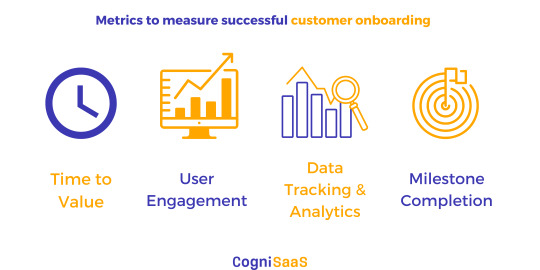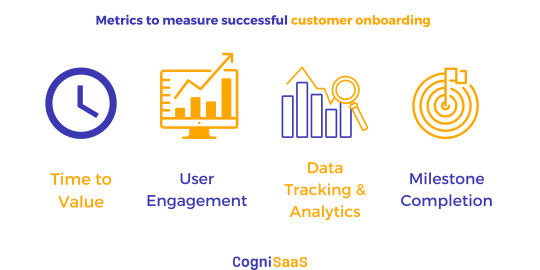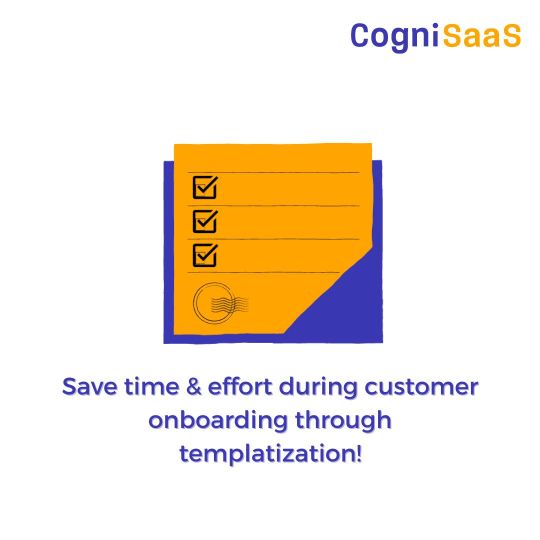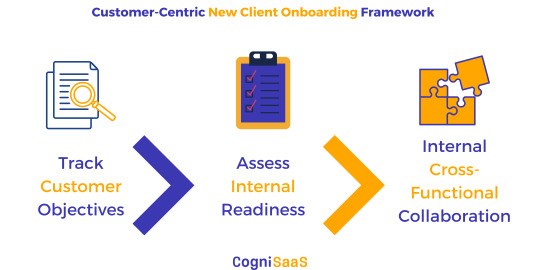Text
0 notes
Text
0 notes
Text
0 notes
Text
Customer-Centric’ Framework | SaaS
The B2B SaaS industry struggles from not being able to set the right 'customer-centric' framework for its new client onboarding process. Numerous industry reports on client churn stats have shown that the seeds of a client renewal or saas churn are actually sown during the client onboarding stage in most cases (excluding the cases when churn happens because of external/client org issues).
What Is Client Onboarding?
Client onboarding is a simple process of getting your customers acquainted with your product. In retrospect, it is not just about teaching your customers how to use your product. In fact, client onboarding, especially in SaaS, is all about aligning your customer’s goals with your product.
What Seems To Be The Issue With The New Client Onboarding Process?
Based on my experience and conversations with several other SaaS industry leaders and a focused market survey we had conducted recently on this topic, I was able to put a pin on this issue.
It seems that while Sales, Marketing, Product, and Account Management (with a new incarnation of 'Customer Success') have evolved (to a good extent) from the legacy ‘upfront license+AMC’ model to the SaaS model, the current client onboarding process and the rest of the post-sales processes in many B2B SaaS companies are still done the same way as it was done even a decade earlier.
Conclusion
To conclude, this new client onboarding framework would not only solve the customer onboarding and churn challenges but also, in the future, this sort of approach would become a ‘competitive advantage’ for a B2B SaaS company as it empowers the entire post-sales operations to be true ‘customer centric’ and ‘data-driven’.
0 notes
Text

customer onboarding
0 notes
Text
Customer success is a method businesses use to derive value. Here is a guide to achieving customer success with effective strategies.
Introduction
Customer success is a term that has become popular in the technology world in recent years, thanks to social media and customer service firms. Nonetheless, that term is somewhat misleading.
Customer success refers to something much broader than customer service. It is about developing a high-efficiency company culture that can help your business grow through direct sales and support of products or services.
The evolution of customer success has brought a changing curve in the growth of enterprise SaaS companies with a customer-centric approach to delivering an exceptional customer experience and driving long-term company growth.
What Is Customer Success?
Customer success is an approach your business uses to derive the most value possible from your products or services to help customers achieve their objectives. It is a client relationship management that aligns your customer with your company’s goals prioritizing your customers’ satisfaction and ensuring they are always progressing toward their goals.
Who Is A Customer Success Manager?
Customer success managers guide customers to know and learn the product/ service from the inside out. They act as a bridge between the support and the sales team taking customers through the sales process into the support phase.
What is a Customer Success Operation?
Customer success operations are the department that takes care of the customer success strategies of a business and executes them. The operations team plays a pivotal role as the core of the business mechanism.
While creating an operations team, all the inter-dependability and resource planning should be well thought out to develop a precise flow that keeps the operations busy and running throughout the company’s lifetime.
0 notes
Text
0 notes
Text
#CogniSaaS#b2b saas#customer onboarding#customer centric#customer success#customer experience#revenue leakage#customer churn#customer onboarding checklist#customer onboarding process
0 notes
Text
How To Lower Your SaaS Customer Churn
Customer churn can significantly impact SaaS businesses and cause inflation in their recurring revenue. A recent study by Accenture Strategy stated that “Enterprise SaaS companies lose $1.6 trillion per year due to customer churn!”
Product Usage Pattern
A customer’s usage rate declining is typically a sign that churn is about to occur. However, there are different usage metrics, such as total users, user log-ins, time spent using the product, etc. Churn is typically the next step if you see that a customer’s usage pattern has significantly changed. You should always know if your customers change how they interact with your product if they switch from one feature to another.
Customer Interaction Level
The level of customer interaction generally declines due to a decrease in product usage or perceived value. Customers no longer see the benefit of calling you to solve their problems. If you notice a drop from an average of eight support calls per month to just one or previously reliable customers who missed two or three consecutive payments, it should cause concern.
Product Downgrade
When customers downgrade to a lower-tier plan, it may signify a downgrade in the product, which lowers MRR and raises the possibility of customer churn. Customer churn can happen due to a customer’s price sensitivity or misalignment of the value proposition.
Seven Strategies To Lower Your SaaS Customer Churn.
Enterprise SaaS companies must ensure that their relationships with current customers improve over time. It will help reduce customer churn and re-engage customers who have left or are about to leave.
Let’s dive right into the strategies!
Offer Effortless Customer Onboarding
It is crucial to offer customers an effortless customer onboarding. Customers are more likely to use your product or service more frequently if you make an excellent first impression. Considering that a customer will remember the impression you left after paying you with their hard-earned money. Also, every subsequent interaction with them will be influenced by how you treated them when they made that commitment.
Define Roadmap For Customers
Having personalized customer onboarding specific to your business is a blessing in disguise. This strategy gives you total control over the rate at which you’re surfacing more information while making it simpler to manage customer expectations. Defining a roadmap to walk the potential customer through the features, functionality, and operation of your product or service can help make the transition easier. Customers are less likely to leave your company if they feel empowered to succeed through your guidance. So you must constantly review and improve your onboarding process and continue to help your customers overcome hurdles.
Increase Customer Engagement
Increased customer engagement will help SaaS enterprises lower their customer churn by putting the right strategy in place and focusing on customer satisfaction. Having an engagement strategy that is simple to implement and regularly informing customers about the benefits of your product or service will help to increase customer engagement and foster long-lasting relationships. You can accomplish this with blogs, newsletters, videos, and other platforms using personalized, product-focused content.
Segment Customer feedback
Every customer is unique and has specific challenges to overcome. So their preferred approaches to overcoming them have to be unique too. Segmenting your customers based on the challenges they tell you about, how they use your services, and what content they read the most helps to show them you’re paying attention. This strategy will encourage customers to refrain from churning and be with you for a long time.
Prioritize Proactive Customer Service
Prioritizing proactive customer service may help you identify issues you were unaware of while onboarding your customers and help you provide the necessary solutions. A bad customer experience can be a significant factor in why customers stop doing business with you, so having an effective customer success strategy is essential for SaaS enterprises. Your customer needs to have an exceptional and memorable experience to recognize the value of your product and remain loyal.
Create A Community Around Your Product
In our very nature, we have a solid desire to fit in. People enjoy having a sense of belonging or being part of a community. You can lower customer churn rate by educating and involving users in online communities. A community provides a platform for customers to actively and frequently engage with each other and share knowledge while allowing you to make your customers feel like they are a part of your brand.
Offer Dedicated Account Managers.
SaaS enterprises can enhance customer retention efforts, boost customer retention rate (CRR), and raise customer lifetime value (CLV) by offering a dedicated account manager for prominent customers. Customers are more likely to stick around when they feel like they know someone at the business personally. Assigning someone sole responsibility for a particular client can be an effective retention strategy.
Hold Regular 1:1 Success Calls And Send NPS Surveys
Retaining customers can be a hectic process. However, you must make an effort to schedule regular 1-on-1 success calls with your clients and monitor their Net Promoter Score (NPS) to learn what aspects of your products are liked and disliked by your customers. These will allow you to find out how and why they use your services and what difficulties they encounter. These will help you strategize your next move and create an effective customer success strategy.
Conclusion
You will lose a significant chunk of your annual recurring revenue if a customer decides they no longer want to use your products and services. It will cost you money and time, and finding a new client may take months.
Check this blog to know more about SaaS Customer Churn: https://www.cognisaas.com/blog/strategies-to-reduce-customer-churn
0 notes
Text

Things You Should Know About Revenue Leakage In B2B SaaS
Learn about the revenue leakage in SaaS companies that go unnoticed, causing the loss of revenue to companies.
0 notes
Text
The Universal Guide On How To Make Your Enterprise SaaS Business Customer-Centric
Customer-centricity in enterprise SaaS is crucial for the growth of a long-lasting and sustainable organizational culture with the qualities or features to fundamentally keep the right customer at the center of every action.
Customer-centric growth means your actions are around what is best for your customer. It is not that you will not pay attention to the product but focus on delivering as much value to your customer's requirements. A positive customer experience can lower the maintenance cost for the existing customer by as high as 33%.
What Does It Mean To Be Customer-Centric?
A customer-centric organization understands customers' wants, needs, and expectations and aims to deliver an unmatched customer experience prioritizing the consumers' point of view.
Customer-centric is often confused with customer-focused. There's a big difference between the two.
Customer-focused is a comprehensive idea of companies to treat their customers right and offer a consistently constructive and relevant experience. However, customer-centric focuses on the customer's lifetime value using segmentation to align and focus the enterprise on a specific targeted high-value customer segment to drive profit.
Why Is Customer-Centricity Important For SaaS Enterprise?
Enterprise SaaS businesses have reconstructed their business Model that meets the needs of their customers with a customer-centric approach.
Customer-centricity requires an approach where customers are an integral part of the business; basing their decisions on customer expectations drives customer satisfaction and loyalty. It also requires taking responsibility and ownership to move. It is essential to create culture-defining customer-centric KPIs with the help of a single source of truth, where customers can easily add, track, and look at the progress of the requested use cases.
0 notes
Text

Metrics to measure successful customer onboarding
Successful customer onboarding happens when you track, prioritize, and deliver customer business outcomes.
0 notes
Text
0 notes
Text

0 notes
Text
What Is Client Onboarding?
Client onboarding is a simple process of getting your customers acquainted with your product. In retrospect, it is not just about teaching your customers how to use your product. In fact, client onboarding, especially in SaaS, is all about aligning your customer’s goals with your product.
When onboarding a new client, it becomes imperative that your onboarding team makes sure that the customer realizes the value of your product. If a customer fails to do so, the chances are high that your new customer onboarding has failed and they will be churning soon.
What Seems To Be The Issue With The New Client Onboarding Process?
Based on my experience and conversations with several other SaaS industry leaders and a focused market survey we had conducted recently on this topic, I was able to put a pin on this issue.
It seems that while Sales, Marketing, Product, and Account Management (with a new incarnation of 'Customer Success') have evolved (to a good extent) from the legacy ‘upfront license+AMC’ model to the SaaS model, the current client onboarding process and the rest of the post-sales processes in many B2B SaaS companies are still done the same way as it was done even a decade earlier.
Traditional Pattern Across New Client Onboarding In B2B SaaS
One broad pattern seen across companies is that the new client onboarding happens in silos with different pieces of the ‘client onboarding action plan’ passed mostly sequentially across cross-functional teams (Sales, CS, Product, Tech, and QA teams involved in the customer onboarding) via proposal docs, meetings, email chains, chat channels, onboarding meeting notes, various excel, CRM, some product centric tools, and interestingly, some key information about customer onboarding next steps stays in Sales/CSMs’ heads as there is no structured way to document in a central platform currently!
0 notes
Text
0 notes
